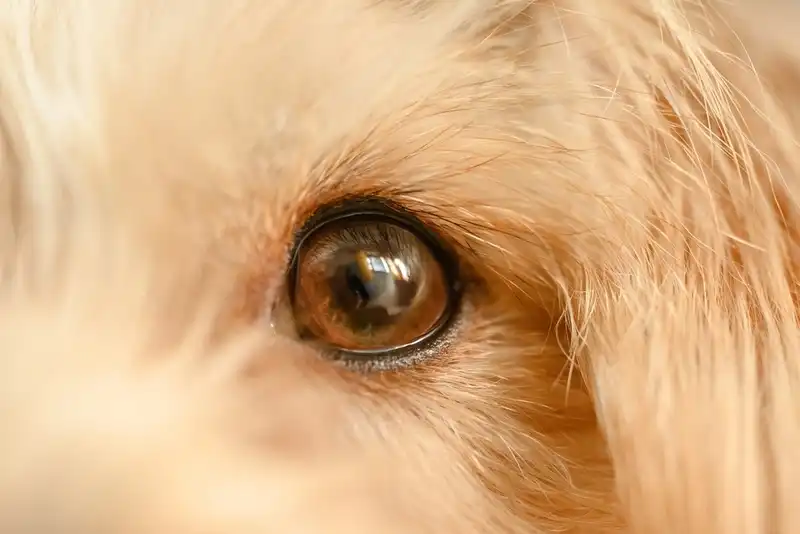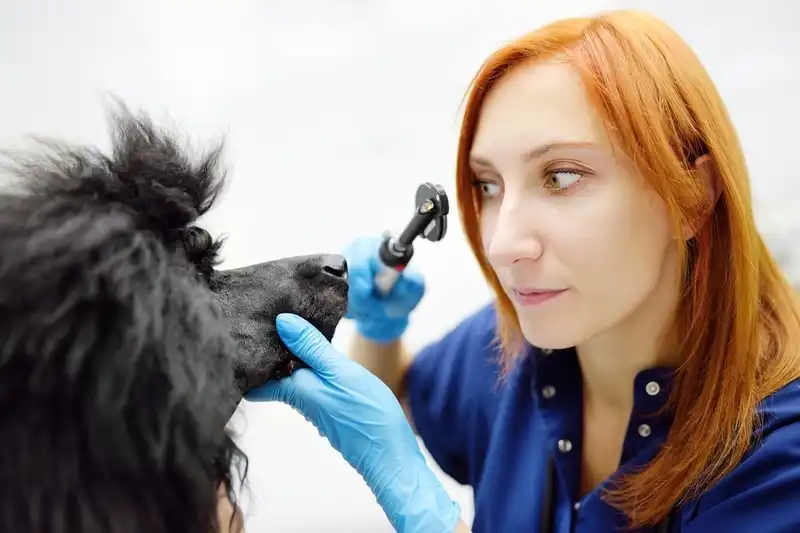The dog has red eyes – why and what to do
Sometimes red eyes in pets can be considered normal, but often it indicates various diseases and conditions that require medical intervention and careful attention from the owner. Therefore, do not postpone a visit to the clinic for diagnosis and treatment. Let’s figure out why a dog has red eyes, the reasons that lead to reddening of the whites, and how and what to treat related pathologies.
The dog has red whites of the eyes – the main thing
- Normally, the red color of whites is found in albino animals, and breeds with a genetic predisposition are also predisposed to it.
- Red eyes are just a sign of the underlying disease. Associated symptoms will help to more accurately determine the cause, itching, lacrimation, and purulent discharge may occur.
- Pathological causes of red eyes in dogs are varied: ophthalmological diseases such as viral, bacterial and fungal infections, systemic pathologies, etc.
- For diagnosis, a specialist may conduct an examination, blood tests, X-rays, examination of eye discharge, measurement of intraocular pressure, and examination of the cornea.
- For treatment, a veterinarian may prescribe local remedies (for example, an ointment or solution). If the appearance of red eyes in a dog is just one of the symptoms of a serious disease – systemic
- drugs: antibacterial, antifungal, antihistaminesfunds. It is possible to perform a surgical operation.
Prevention includes avoiding traumatic situations, maintaining hygiene, choosing a balanced diet, regular medical examinations and vaccinations.
Why Does a Dog Have Red Eyes – 8 Reasons
Redness of the eye is caused by various factors, including genetic predisposition, infectious and non-infectious diseases, injuries, foreign objects, and other causes. This condition can be localized or widespread, affect only one eye or both, be diagnosed for a short time or a long period, and be accompanied by other signs or appear as the only symptom of the pathology.
Let’s look at the most common reasons why a dog’s eyes may be red.

Heredity
In some animals, red eyes are normal, especially if they are carriers of the albinism gene or representatives of breeds genetically prone to redness. These often include dogs with a so-called raw constitution – a large number of skin folds, such as English and French bulldogs , cocker spaniels , basset hounds , bloodhounds , Bordeaux dogs and some others.
Some ophthalmological diseases to which they are prone can also be inherited, which leads to reddening of the whites of the eyes (for example, inversion and eversion of the eyelid).
Belonging to such breeds is the only harmless reason. All other provoking factors require close attention and help of a specialist.
Stress response
In certain situations, red eyes can be caused by stress factors, such as moving, a change of owner, the arrival of a new animal or family member. When the pet calms down, this condition disappears on its own.
A similar effect can be caused by prolonged exposure to the sun or an excessively warm room. This occurs due to the dilation of blood vessels and the fact that blood rushes to the head. In this case, the dog may experience shortness of breath, loss of coordination and difficulty with orientation in space, vomiting and nosebleeds are possible. In such situations, the pet requires emergency veterinary care.

Irritation and mechanical trauma
Sometimes it happens that one or both eyes of a dog become red and watery after a walk, especially if there is a strong wind and dust outside. Small particles that get on the mucous membrane of the cornea cause irritation and dryness, which leads to irritation and, as a result, redness. A similar effect can also be caused by smoke, caustic fumes of household chemicals and other irritants.
Mechanical injuries often occur as a result of careless play, fights with other animals, and various physical activities.
Conjunctivitis
This is an inflammation of the membrane that lines the outside of the eyeball and the inside of the eyelids. The disease can be caused by various reasons, primarily viral and bacterial infections. It can manifest itself as redness of the eyes and other symptoms, but redness of the conjunctiva— the most pronounced symptom by which one can suspect this particular disease. In certain forms, caused by infectious agents, conjunctivitis can be transmitted to people and other pets.
Contact allergy
Red eyes are often a characteristic sign of allergic reactions, in particular contact allergy. It develops when the skin and mucous membranes come into contact with environmental agents, such as aerosols, household chemicals, hygiene products, tobacco smoke and other substances. In addition to visual impairment, it usually manifests itself as damage to the skin.
In this case, it is critical to identify the allergen to eliminate contact and prevent re-irritation.
Infectious diseases
Often, red eyes are a sign of serious infectious diseases of viral, bacterial, fungal or protozoan (caused by simple microorganisms) nature: plague of carnivores, chlamydia, toxoplasmosis, thelaziasisand others. Many of them, if left untreated, can lead to uveitis (inflammation of the vascular membrane of the eye), blindness, and some, such as distemper, have a high risk of death.
This is one of the reasons why even minor redness of the eyes should prompt the owner to pay attention to the health of the pet.
Other ophthalmological diseases
Another reason for red eyes in dogs is considered to be problems with the eyelids and individual structures of the visual organ. For example, eversion or inversion of the eyelids (more common in animals with a raw constitution), prolapse of the lacrimal gland (often this disease is inherited), blockage or congenital developmental disorder of the lacrimal ducts, blepharitis – inflammation of the eyelids.
As a rule, such diseases manifest themselves quite clearly, unlike some other pathologies, so owners can easily suspect something is wrong by a change in the usual appearance of the eyes.

Systemic diseases
In some cases, redness of the eyes and discharge of pus or other fluids from them accompanies serious systemic diseases. In particular, with hypertensionEyes may become red due to high pressure, and tumors in the head area may also affect the color of the whites of the eyes.
Some ophthalmologic diseases, such as blepharitis, may be associated with immune-mediated pathologies in which the immune system does not function properly.
Detecting systemic pathologies can be difficult because of the wide range of possible symptoms.
Associated symptoms
When owners talk about red pupils in their dog, they, of course, do not mean the pupil, which always remains black, but the conjunctiva. In any case, if it seems to you that the pet’s eyes have changed, there is lacrimation, partial or complete closure of the eyelid, itching, clouding, this can be a sign of many pathologies. The veterinarian will be able to distinguish one from another by the accompanying symptoms that the owner notes in the dog.
Stress response
- Changes in behavior, apathy or anxiety, dilated pupils, vomiting if overheated, fever.
- Eye irritation and mechanical injuries
- Itching, lacrimation, hemorrhages, swelling of the eyelids, inflammatory and purulent processes, photophobia, presence of a foreign object
- Conjunctivitis (can be a result of other causes described)
- Purulent discharge from the eyes, pain, itching, photophobia, sticking of the eyelids
- Contact allergy
- Discharge from the eyes and nose, lacrimation, itching of the skin, scratching, damage
- Infectious diseases
- Increased body temperature, apathy, decreased activity, digestive disorders, vomiting, diarrhea
Other ophthalmological diseases
Violation of the normal structure of the eyes (inversion or eversion of the eyelid), discharge of pus and lacrimation from the eyes, loss of eyelashes, itching, various spots on the cornea
Systemic diseases
Dilation of pupils, diarrhea, vomiting, seizures and other symptoms depending on the disease
Diagnosing problems
Diagnosing red eyes requires the experience and professionalism of a veterinarian, as red eyes in a dog can be a sign of various diseases or problems.
- When making a diagnosis, a veterinarian may adhere to the following algorithm:
- Visual inspection.The specialist conducts a thorough examination, studying the color, shape and condition of the mucous membrane. Particular attention is paid to the presence of redness, irritation, swelling, discharge, foreign body.
- A more detailed examination of the eyes.Includes measurement of intraocular pressure to rule out glaucoma (increased intraocular pressure). Additionally, a corneal examination using fluorescein may be performedto detect damage or ulcers.
- Laboratory research.If a bacterial or viral infection is suspected, a veterinarian may take a swab from the eye for subsequent microbiological testing. This will help identify the specific pathogen and select effective drugs.
- Additional diagnostics.Additional tests may include x-rays if an injury or tumor is suspected. Tests may also be ordered to evaluate the dog’s overall health and look for signs of systemic diseases that may be affecting the eyes.

How and what to treat pathologies with?
- Treatment of eye redness is possible only after determining the underlying cause and as prescribed by a veterinarian.
- Having established a diagnosis, the specialist may prescribe the following measures:
- Daily rinsing of eyes with boiled water or special products, such as furacilin solution or lotion for animal eye care;
- Use of local or systemic drugs: antibiotics (for example, based on amoxicillin, levofloxacin), antifungal drugs (for example, based on enilconazole, miconazole) for infectious pathologies, anti-inflammatory drugs (for example, based on prednisolone) for systemic diseases, etc.;
- Carrying out surgery in case of certain mechanical injuries, penetration of a foreign body.
- Regardless of why your dog has red eyes, it’s important to provide your pet with a comfortable environment, including a quiet place to rest, clean water, and proper nutrition. A proper, balanced diet rich in essential nutrients will support the immune system and overall health. And regularly cleaning the eyes with special products will help relieve irritation and reduce discomfort.
If a puppy has red eyes
Puppies are less likely to get eye inflammation than adult dogs. However, if you notice a problem with your dog’s vision, you should pay attention to it and consult a veterinarian. Since puppies are more sensitive to many infectious diseases, they pose a greater danger to them, as their immunity is just developing.
Red eyes in puppies may be accompanied by swelling of the eyelids and frequent blinking. In some cases, the pet may show restlessness, anxiety, or discomfort associated with pain or itching.
Otherwise, the approach to diagnosis and treatment is no different from that for adult dogs.
Possible complications of pathologies
Most often, complications of ophthalmological diseases, in which dogs have red whites of the eyes, are a decrease in visual acuity up to blindness. This is possible if you ignore the symptoms and do not follow the recommendations of a veterinarian.
Advanced or severe injuries may require surgery, sometimes even removal of the eyeball.
If the redness is caused by infectious or systemic diseases, the complications can be very dangerous – for example, impaired coordination of movements, damage to the central nervous system, exhaustion, coma, etc.

Prevention of eye problems
Here are some important measures that will help maintain the health of your pet’s eyes and prevent them from becoming red:
- Regular visits to the veterinary clinic at least once a year.
- Daily eye hygiene: Regularly cleaning the natural secretions will help remove dust, dirt, and other irritants that can cause infection or inflammation.
- Protection from environmental influences. Prevent your pet from coming into contact with aggressive household chemicals and other irritants.
- Proper nutrition. It is important to choose a diet for your dog that is appropriate for its age and breed.
- Safe Space: Avoiding fighting or dangerous play will help prevent eye injuries.
Eye health is an important part of your dog’s overall health. With proper prevention and regular care, you can reduce the risk of problems and help your pet maintain their vision for years to come.






